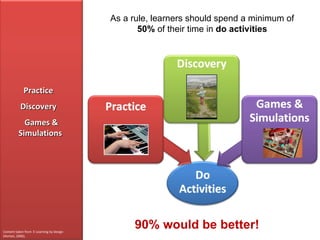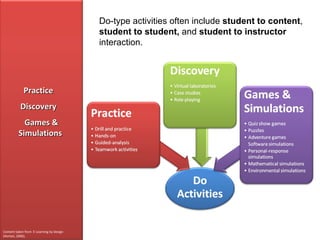Do activties
- 1. As a rule, learners should spend a minimum of 50% of their time in do activities 90% would be better! Practice Discovery Games & Simulations
- 2. Do-type activities often include student to content , student to student, and student to instructor interaction.? Practice Discovery Games & Simulations
- 3. Photo by r_bowley Photo by Jeremy Toeman Photo by ggBO Photo by Challenge Business Content taken from E-Learning by Design (Horton, 2006). Practice Discovery Games & Simulations
- 4. Photo by Computer Science Geek Photo by Prato9x Photo by Worldmegan Content taken from E-Learning by Design (Horton, 2006). Photo by Houstonian Photo by Dan Pupek Practice Discovery Games & Simulations
- 5. Photo by Betina Tizzy Photo by JulinaBleeker Photo by blugrn Practice Discovery Games & Simulations
- 6. Photo by Alphachimp Studio Practice Discovery Games & Simulations
- 7. Photo by .imelda Photo by Jckcorbett70 Content taken from E-Learning by Design (Horton, 2006). Photo by Shockwellenreiter Photo by Today is a Good Day Photo by Thomas Small Photo by cafĻĶ.com Practice Discovery Games & Simulations
- 8. Developing games and simulations are difficult, time consuming and expensive. Use different program applications to create games (e.g. StudyMate). Use games and simulations that have already been created (e.g. MyITLab). Use a design team to help you design, plan, specify and produce your game or simulation. Practice Discovery Games & Simulations
- 9. Photo by r_bowley Photo by Jeremy Toeman Photo by ggBO Photo by Challenge Business Content taken from E-Learning by Design (Horton, 2006). Brainstorming List examples of practice activities for your online course that are aligned with reaching your primary objectives.
- 10. Photo by Betina Tizzy Photo by JulinaBleeker Photo by blugrn Brainstorming List examples of discovery activities for your online course that are aligned with reaching your primary objectives.
- 11. Photo by .imelda Photo by Jckcorbett70 Content taken from E-Learning by Design (Horton, 2006). Photo by Shockwellenreiter Photo by Today is a Good Day Photo by Thomas Small Photo by cafĻĶ.com Brainstorming List examples of games and simulations for your online course that are aligned with reaching your primary objectives.











